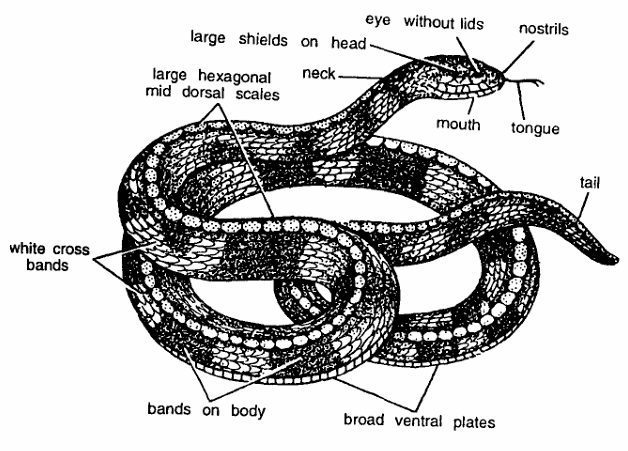Introduction
The genus Bungarus, commonly known as kraits, comprises highly venomous snakes found primarily in South and Southeast Asia. Known for their striking black and white bands and nocturnal behavior, kraits are formidable predators in their habitats. Despite their lethality, they are generally shy and prefer to avoid confrontation with humans.
Classification of Bungarus (Krait)
- Phylum :- Chordata (Dorsal tubular nerve cord, notochord and gill-slits present.)
- Group :- Craniata (Definite head, Cranium with brain present.)
- Sub phylum :- Vertebrata (Vertebral column present.)
- Division :- Gnathostomata (Jaws and paired appendages present.)
- Super Class :- Tetrapoda (Paired limbs, lungs, cornified skin and bony skeleton.)
- Class :- Reptilia (Scaly vertebrates. Right and left aortic arches present. Single condyle. Pulmonary respiration. Embryo with amnion and allantois.)
- Sub Class :- Diapsida (Skull with two temporal openings separated by post-orbital and squamosal.)
- Order :- Squamata (Lizards and snakes with horny epidermal scales or shields. Quadrate bone movable. Vertebrae procoelous. Anal opening transverse.. Vertebrae amphicentrous.)
- Sub-order :- Ophidia (Snakes. Limbs, feet, ear openings sternum and urinary bladder absent. Mandibles jointed anteriorly by ligament. Tongue slender, bifid and protrusible. Left lung reduced.)
- Family :- Elapidae (2 or more short, rigid erect fangs.)
- Genus :- Bungarus

Geographical distribution
- Found across South Asia, Southeast Asia, and parts of China.
- Key regions :-
- India, Sri Lanka, Nepal, Bangladesh, Bhutan.
- Myanmar, Thailand, Laos, Cambodia, Vietnam, and Indonesia.
- Southern China and parts of Malaysia.
Habit and habitat
- Kraits are highly adaptable and occupy a range of habitats, including:
- Forests and Woodlands: Dense vegetation provides cover and hunting grounds.
- Grasslands and Farmlands: Frequently found in cultivated fields and near human settlements.
- Riverbanks and Wetlands: Often seen near water sources.
- Urban Areas: Occasionally found in suburban and rural areas due to their attraction to rodents.
- During the day, kraits hide in burrows, under logs, or inside crevices, becoming active primarily at night.
General Characteristics of Bungarus (Krait)
- Commonly called as Krait.
- Body is elongated and cylindrical, measuring one meter in length. Body divided into head, neck, trunk and tail.
- Colour of body steel-blue and dark-blue. Dark-blue, patches alternate with white cross bands.
- Head is not differentiated from the neck. Loreal absent. Post-ocular, preocular and supra-labial 2, 1
- and 7 in number respectively. Fangs small. Head contains eyes, nostrils, bifid and protrusible tongue.
- Eyes are of moderate size with round pupils.
- Scales are smooth forming 13-17 rows. Ventrals are 194-234 and caudals 42-52.
- Large mid-dorsal hexagonal scales are present. Ventral scales beyond the anal region are in a single row.
- Oviparous. Female shows parental care.

Ecological Importance
- Rodent Control: They play a critical role in controlling rodent populations, particularly near human settlements, thus reducing crop damage and disease transmission.
- Predator-Prey Dynamics: They are both predators (feeding on small mammals, reptiles, and other snakes) and prey for larger animals, contributing to the balance of the food web.
- Ecosystem Health Indicator: Their presence indicates a healthy and functioning ecosystem, as they rely on stable environments and abundant prey.
Conservation Status
- Global Status: Most species are listed as Least Concern on the IUCN Red List, but specific species, like the Sri Lankan krait (Bungarus ceylonicus), face localized threats and are listed as Vulnerable.
- Threats:
- Habitat destruction due to agriculture, urbanization, and deforestation.
- Persecution by humans due to fear of their venomous nature.
- Roadkill incidents in areas of human encroachment.
- Conservation Efforts:
- Legal protection in many countries to prevent hunting and habitat loss.
- Public awareness campaigns to reduce unnecessary killing.
- Conservation programs focusing on habitat preservation.

Special features
- Venom Potency: Kraits possess one of the most potent neurotoxic venoms among snakes, causing paralysis by blocking nerve signals. Despite their lethality, they are non-aggressive and prefer flight over fight.
- Banding Pattern: Distinct black and white or black and yellow bands provide camouflage in low light and act as aposematic (warning) signals.
- Nocturnal Behavior: They are most active at night, hunting other snakes, rodents, and lizards. During the day, they remain hidden.
- Cannibalistic Tendencies: Kraits are known to feed on other snakes, including venomous species, showcasing their unique predatory habits.
- Low Aggression Toward Humans: Unlike some snakes, kraits rarely bite unless provoked or stepped on, even when encountered.
Identification
- Since this snake contains hexagonal scales on body on dorsal side and above features, hence it is Bungarus

Pingback: Top 10 Most Venomous Snakes in the World | Zoologyverse | 2025